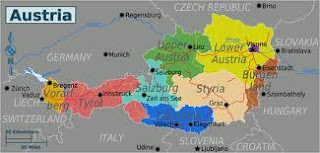During one of my English courses for the University of Cambridge Proficiency Exam, I met the PA to the CEO of a large Austrian company operating out of Linz. She told me how difficult it was to recruit employees from Vienna, Graz or Innsbruck to work in Linz. According to her, it would be much easier find someone from Hamburg or Berlin willing to move to Linz than from anywhere within Austria. That struck me as very odd. After all, we sold our house and moved the whole family to Upper Austria for professional reasons. Admittedly, you have to put in the effort and be prepared to adjust to some extent. But, on the whole, it’s by no means impossible to settle down and find friends in new surroundings. And for employees from Graz, Vienna or Klagenfurt, it would only mean moving within Austria. Not to a foreign country! But I’m not sure these potential employees see it like that. Even when they are prepared to accept a job in Linz, actually living there is a different matter altogether. One of my husband’s colleagues commutes between Vienna and Linz on a daily basis, another one between Salzburg and Linz.
Austria is made up of nine regions: Vorarlberg, Tyrol, Salzburg, Styria, Burgenland, Carinthia, Upper Austria, Lower Austria and Vienna. It’s these regions that figure very prominently in Austrian awareness. Whenever you meet Austrians for the first time, you are likely to be told fairly quickly which part of the country they were born in. I’ve often wondered why. As a means of identification, the region someone was born in seems to be much more important than the country as a whole. It’s Upper Austrian first, Austrian second. Reading a newspaper, one piece of information you are sure to get on any Austrians mentioned there is their regional origins. In Germany, no one really cares whether they come from North Rhine-Westphalia, Hesse or Lower-Saxony. And it definitely doesn’t seem worth mentioning in a newspaper article. (With Bavarians it’s different, though. Bavarians are special. They insist on marching to a different tune all the time.)
Perhaps it’s against this backdrop of regional identification – rather than a national one – that you have to look at the resistance to tackling the long overdue administrative regional reforms experts have been demanding for decades. Compared with their small degree of actual independence, the regions maintain disproportionately large and extremely expensive administrations. According to experts, the potential for urgently needed savings is enormous. Why then don’t Austrians just go on with the reforms? Maybe it’s something to do with the deep-seated mistrust of “the Viennese” I’ve noticed throughout the rest of Austria. Vienna is far away, far too arrogant and far too extravagant. Nothing positive is likely to come from there. Let’s stick to the regions instead! Even if it means squandering millions and millions of euros.
There’s yet another point closely connected to the question of regional identity: the importance of dialects in the lives of many Austrians. Austrians are proud of their dialects. Their dialects are typical of the regions, and they function as distinguishing marks. It doesn’t seem to matter that Upper Austrians don’t necessarily understand Austrians from Vorarlberg, Tyrol or Carinthia and vice versa. It’s probably due to a lack of horizontal mobility, the tendency to stay – or at least go back to – where you come from that dialects have survived as widespread and unchanged as they still are. Perhaps being deeply rooted in one particular area is a feeling I just don’t understand. But moving somewhere else is definitely worth a try.


No comments:
Post a Comment